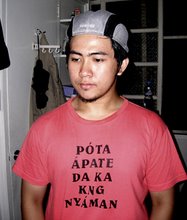ANGELES CITY – When the band Asthma performed “Atin Ku Pung Singsing,” it wasn’t in Mon David jazz or the Sapni Nang Crissot’s classic or the ArtiSta. Rita’s ballad. It was rock – boisterous and heavy on the rhythm.
The concert, staged on Feb. 18, was, as the youth visual art group Kapangulis hailed on the theater backdrop, “RocKapampangan: The Birth of Philippine Kapampangan Rock.”
The 16 bands proved this to be a real breakthrough.
Thirteen transformed the polosa (extemporaneous songs) of Pampanga’s rural masses into rock songs. In this league were Fourth Clan (Dayang Kapampangan), Tibuan (Sintang Pangarap), Chilimansi (Istorya nang Raffy Balboa), 5 Against the Wall (Sibul na ning Arayat), Mental Floss (Ing Lugud ning Indu), Neophytes (Katatagan ning Pamakilaban), THEM (Kasamsaman), Cyclo (Dalumdum ning Bengi), Amygdala (Aldo ning Kekami Kasal), Silence (Indulang Balayan), Pulse Rhythm (Saug a Malati) and Fine Time (40 Aldo).
Dialogo gave rock form to “Atsing Rosing,” an old courtship song. Two bands – the Nora Aunor Fans Club and Mernuts – composed two originals, “Kaplas” and “Aliwa ka Talaga.”
Their performances attracted a large young crowd. The venue, the Holy Angel University’s Plaza San Jose, was jampacked.
Branding the “harvest” as rocKapampangan was right enough, said Jason Paul Laxamana, the director of what he called the first-of-its-kind project by his group, the Kalalangan Kamaru.
The bands used the Kapampangan language and folk music, and drew subjects from the local context, said Laxamana, who calls himself an “independent cultural worker trying to finish my senior sociology course at the University of Philippines in Diliman.”
“Doing this music is a first step in developing the Kapampangan consciousness. These bands showed an interest in the language, which is hardly used now in day-to-day conversation,” he said.
Bridge to youth
Opening the concert, he spoke the native language: “The promotion of our culture does not rely on one person or one group. It relies on us, the young generation.” RocKapampangan then, he said, was a way of reaching out to the youth, a sort of bridge to those growing up largely on western music.
His dream? Kapampangan music would enjoy heavy playing on iPods and MP3s.
Ram Nulud, vocalist of the Nora Aunor Fans Club, said: “It used to be baduy (awkward) to sing in Kapampangan. Apagmaragul mu ne man (You can really be proud of it).”
For Mernuts, a band of three girls and three boys based in Tarlac City, the crossover to the Kapampangan language began as a “katuwaan (for fun).” Through them, Beyonce Knowles’ “Irreplaceable” got a Kapampangan version on YouTube in March 2007.
“Aliwa ka Talaga” was composed two weeks before the album was recorded. “We also want to express the Kapampangan influence,” said guitarist Chao Chua.
Whether the native consciousness has seeped in or is still in its infancy, those who have gone before them were all praises. Andy Alviz, composer and artistic director of the ArtiSta. Rita, said, “Finally, the local music landscape attracted younger artists.”
Totoy Bato, the most popular in Pampanga’s thinning army of polosador (singers of extemporaneous songs), appealed to the listeners. “Suportan yu la sana reneng bandang Kapampangan (I hope you support these Kapampangan bands),” he said.
Local historian Mike Pangilinan was pleased. “It’s a breakthrough kasi sibukan da (they tried the form). They did not sound like copycats.”
And how do you explain the photograph, circa 1899, of the Macabebe Scouts, the people recruited by the Americans to capture Gen. Emilio Aguinaldo, on the CD cover?
“With their long hair and defiant, maverick attitude, the Macabebe Scouts were history’s original rockers. The album is a tribute to them. They’ve always been misunderstood by society, just like today’s rockers,” said Robby Tantingco, executive director of the HAU Center for Kapampangan Studies.







No comments:
Post a Comment